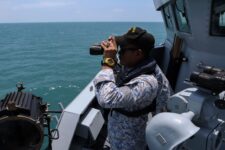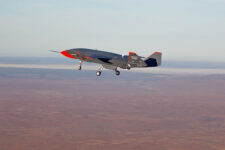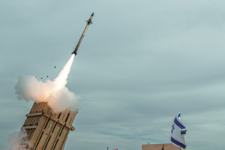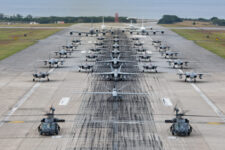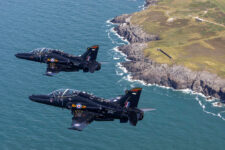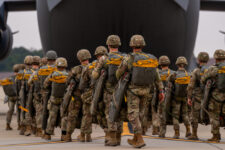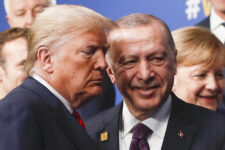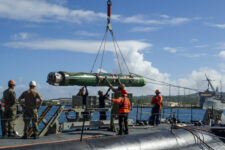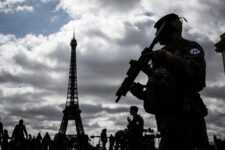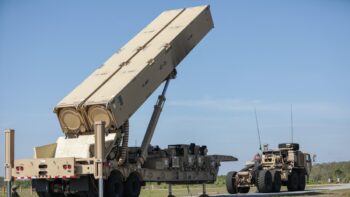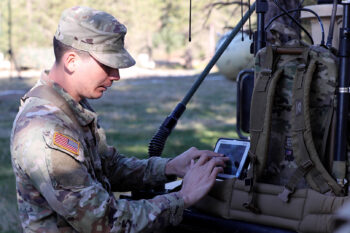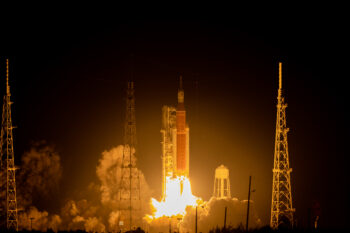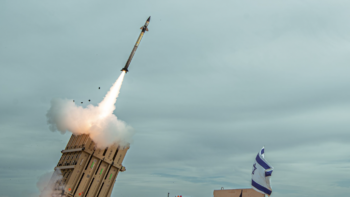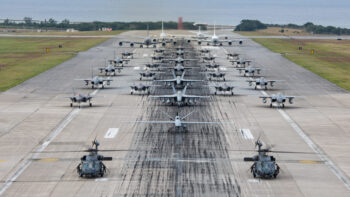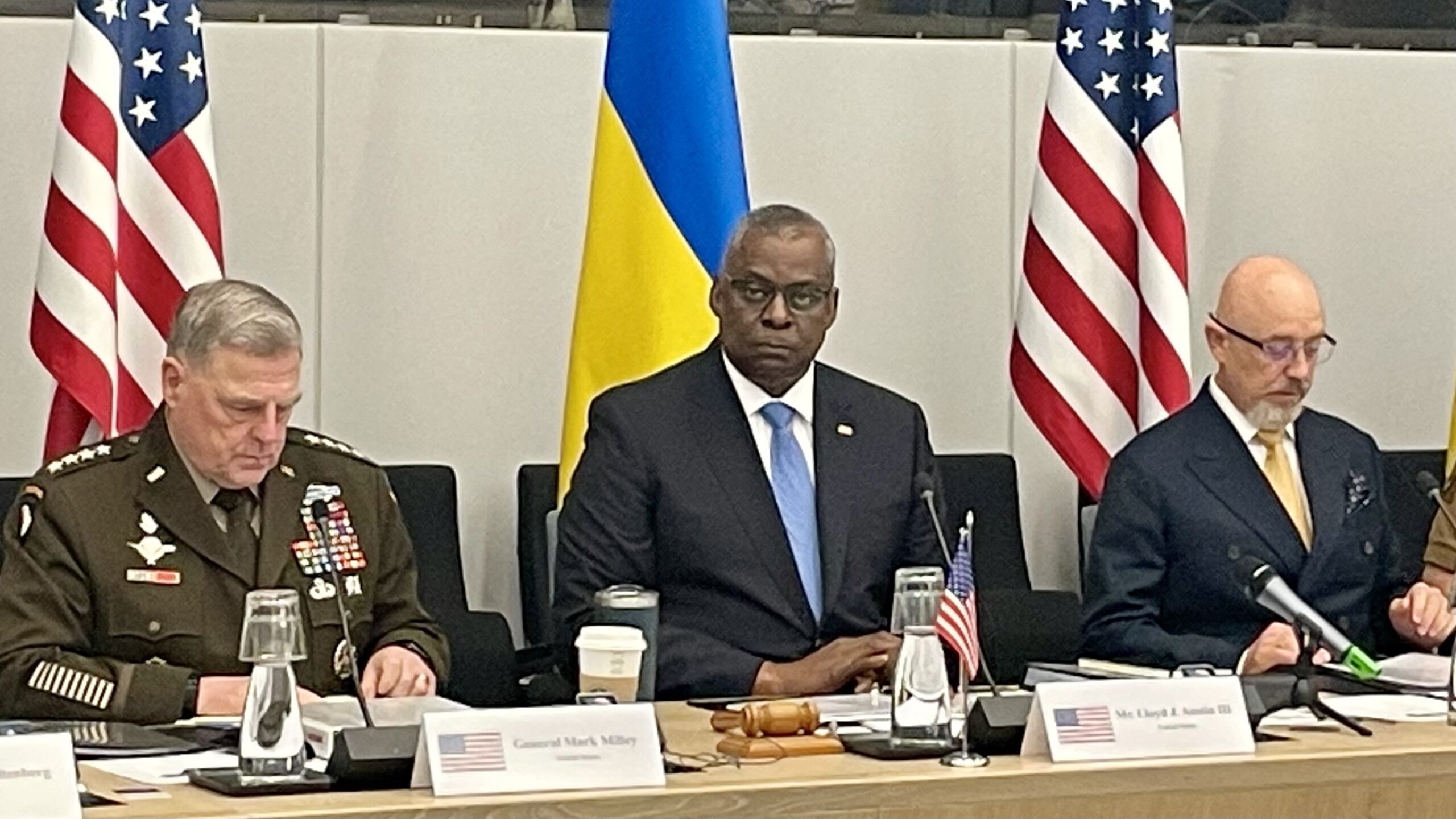
US Defense Secretary Lloyd Austin sits between Ukraine’s defense minister Oleksiy Reznikov (right) and US Chairman of the Joint Chiefs of Staff Gen Mark Milley (left) on June 15 during the kickoff of a Ukraine Contact Group meeting in Brussels. (Breaking Defense/ Ashley Roque)
BRUSSELS — With all eyes on Ukraine’s counteroffensive, defense leaders have descended on Brussels for back-to-back meetings revolving, in part, around sustaining Kyiv’s military power and laying the groundwork for next month’s Vilnius summit.
US Defense Secretary Lloyd Austin kicked off the two-day sprint today by gaveling in the Ukraine Defense Contact Group and calling the ongoing war “a marathon, not a sprint.”
“We will continue to provide Ukraine with the urgent capabilities that it needs to meet this moment… as well as what it needs to keep itself secure for the long term from Russian aggression,” Austin said while sitting between Ukraine’s defense minister Oleksiy Reznikov and US Chairman of the Joint Chiefs of Staff Gen Mark Milley.
But with that call for action, there was no public assessment of Ukraine’s short-term prospects as it’s much-anticipated counteroffensive begins. Milley told reporters it is premature to estimate how long operations will continue but warned that it will be a “difficult” and “violent” fight. Austin noted that there is battle damage on both sides.
“What’s important is that..the Ukrainians have the ability to recover equipment that’s been damaged and repaired where possible, to get that equipment back into the fight, and also that they have, we have a means to continue to push capability forward,” Austin later added.
While much of today’s event took place beyond closed doors, Austin said in addition to discussing Ukraine’s “changing circumstances on the ground” and adapting weapon packages, participants delved into the details of the forthcoming F-16 center that will be stood up in an unidentified European NATO member country. (The Netherlands is the European F-16 training coordinator and is assisted by Denmark.)
RELATED: Netherlands outlines 3-step F-16 training plan for Ukraine
Reznikov also hinted that Sweden may join what he called the “bird coalition” and has offered for Ukraine to test out its “capabilities.” However, he did not disclose if the offer centers around the Swedish SAAB Jas Gripen, and a spokesperson for Sweden’s minister for defense did not immediately respond to Breaking Defense’s questions about what “capabilities” might be in play.
Germany and Poland were also tapped to discuss the next steps for sustaining Ukraine’s fleet Leopard tanks, though Austin did not provide additional details about the plan.
NATO: A Bigger Commitment And The Swedish Question
On Friday talks will continue in Brussels but will shift to a NATO Defense Ministerial meeting billed as a scene-setter for the mid-July Vilnius summit in Lithuania’s capital city. For his part, NATO Secretary Jens Stoltenberg told reporters his message this week is for all allies to stand by Ukraine as long as possible. Additionally, he wants to spend Friday nailing down consensus for increasing NATO members’ defense spending commitment and getting Sweden into NATO.
“When leaders meet in Vilnius next month, they will agree to a stronger pledge, an enduring pledge, and the pledge that has to come into effect immediately and not within a decade,” Stoltenberg said in reference to raising the defense spending threshold beyond the 2 percent Gross Domestic Product (GDP) objective.
Anduril’s Fury hopes to woo Australia away from Boeing’s Ghost Bat
Anduril has held talks with other countries in the region, executive David Goodrich said in an interview, but Australia is clearly a prime target.
In 2014, after Russia annexed Ukraine’s Crimean Peninsula, NATO allies agreed to reach that target by 2024. But that looming date coupled with a war raging on European soil, prompted Stoltenberg and others to ask for more.
“That 2 percent of GDP for defense is not something we should strive towards with the ceiling, but the minimum needed to be invested in our shared security,” he added.
However, in 2022 only seven of NATO’s member states actually met the defense spending, according to figures from the alliance’s annual report. Those countries included the United States, Estonia, Greece, Latvia, Lithuania, Poland and the United Kingdom, while Croatia and France fell just short of the standard.
Washington has been publicly pushing the percentage hike, and today Estonia’s defense minister Hanno Pevkur said he supports inching the GDP commitment up to 2.5 percent. Latvia’s defense minister Ināra Mūrniece, meanwhile, argued that it should be slightly higher and urged allies to “join us” on the quest to reach the 3 percent GDP threshold by 2027.
GDP talk aside, Stoltenberg said he will spend Friday continuing his push for Sweden to become a full-fledged member of the alliance by the mid-July summit, while also cautioning that Turkey, which has been playing spoiler to Sweden’s ascension, continues to have “legitimate security concerns.”
“I cannot guarantee you that that will happen, but I’m still working hard to ensure the accession of Sweden as soon as possible,” Stoltenberg said.

